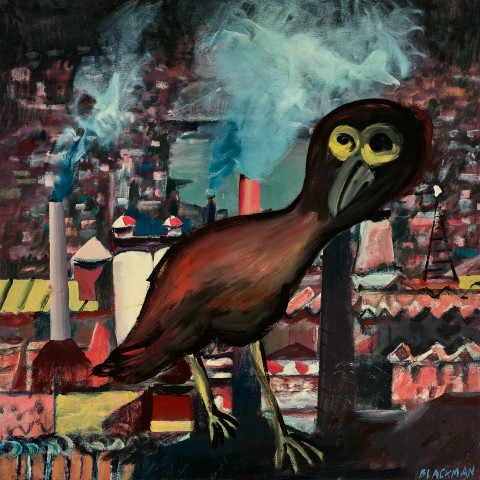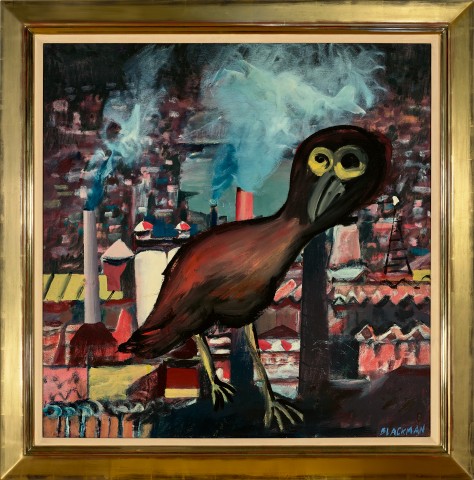BIRD OVER THE CITY, 1952
CHARLES BLACKMAN
enamel on board
91.0 x 91.0 cm
signed lower right [in 1994]: BLACKMAN
bears inscription on label attached verso: BIRD OVER THE CITY / 1952
Charles Blackman, Sydney
Private collection, Melbourne, acquired from the above in the 1990s
Paintings and Drawings: Charles Blackman, New Gallery, Adelaide, November 1953, cat. 3
Charles Blackman: Unseen Images, Mossgreen Gallery, Melbourne, April 2012
Wells, R., 'Insight into the artist's studio and mind', The Age, Melbourne, 12 April 2012, p. 16 (illus.)
Boy with a Bird, 1952, illus. in Moore, F. St. John, Schoolgirls and Angels, National Gallery of Victoria, Melbourne, 1993, p. 32
Charles Blackman was essentially self-taught as an artist, but he was an omnivorous reader and observer. He honed his distinctive drawing skills as a copy boy on the Sun newspaper in Sydney between 1942 and 1947, but it was the inner worlds he discovered through reading that furnished him with many of his early imagery. These included authors and poets such as Rimbaud, Verlaine, Kafka, and Baudelaire. This was a rich vein of inspiration, but the ‘texture’ of these literary sources was magnified by his practice of reading aloud to his wife Barbara as her sight slowly declined during the early years of their marriage. After a peripatetic period travelling between Melbourne, Sydney and Brisbane, the young couple settled in a tiny shed behind a mansion in East Melbourne, and Blackman would often navigate the semi-industrial back streets of nearby Richmond after work at a variety of jobs. Such a landscape may be seen in the background of Bird over the city, 1952, dominated by an all-knowing, powerful owl which stares, unblinking, back at the viewer.
As early as 1950, Blackman identified with birds, writing to Barbara: ‘There are love letters, newsletters, and fish and bird letters, or there used to be, that is; but now the metamorphosis is complete. I am purely and simply a bird so all you will receive are bird ones.’1 In May 1951 the Blackman’s moved into a disused coach house in Hawthorn, which Charles quickly converted into a living space and studio. By this time, he had already met many of Australia’s most important artists of the period, such as Joy Hester, Arthur Boyd and John Perceval, as well as the influential patrons John and Sunday Reed who showed him Sidney Nolan’s ‘Ned Kelly’ paintings, which were stored at their farmhouse Heide. Brimming with inspiration, Blackman set to work, and mounted an exhibition at the coach house in 1952. He was delighted when Danila Vassilieff, visited the show. ‘We were honoured at his coming. We knew his myth, this Cossack adventurer.’2 Vassilieff was impressed by what he saw but warned Blackman to ‘get off Sid’s back. He’s not a horse, you know,’ a recognition that the young artist needed to find his own voice and not just ape the work of others.3 Rising to the challenge, Blackman began a sequence of new works featuring cats and birds, as well as his earliest depictions of schoolgirls. The Blackmans travelled to Brisbane after the exhibition, staying at Barbara’s mother’s house in Kelvin Grove, and here he painted the self-portrait Boy with a bird, with the figures set against a collage of ‘Queenslander’ houses, wallpaper and vegetation. Following their return to Melbourne, he painted Bird over the city, which reconfigures the background to include Richmond’s brewery silos set hard against chimneys of the State Electricity power station. Indeed, it is not hard to imagine some of his schoolgirls scurrying through these darkened lanes. When Bird over the city and its related works were exhibited in Adelaide in 1953, he was praised for the ‘movement (and) vitality’ of his paintings4, with senior artist Ivor Francis going so far as to claim that Blackman was ‘the most stimulating, original and promising younger painter we have seen for a long time.’5
1. St John Moore, F., Charles Blackman: Schoolgirls and Angels, National Gallery of Victoria, Melbourne, 1993, p. 32
2. Blackman, B., Glass after glass: autobiographical reflections, Penguin, Melbourne, 1997, p. 154
3. Danila Vassilieff, cited in St John Moore, op. cit., p. 33
4. Young, E., ‘City display by young Vic. Artist’, Advertiser, Adelaide, 17 November 1953, p. 14
5. Francis, I., ‘A promising painter’, News, Adelaide, 17 November 1953, p. 5
ANDREW GAYNOR


